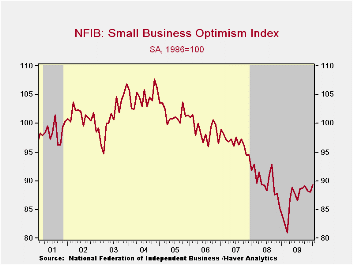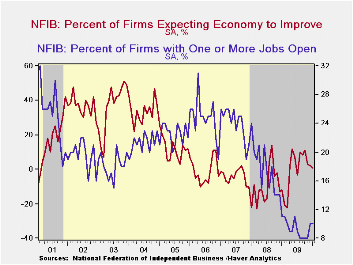 Global| Feb 09 2010
Global| Feb 09 2010U.S. Small Business Optimism Improves Modestly
by:Tom Moeller
|in:Economy in Brief
Summary
A sense of modest improvement returned to small business. The National Federation of Independent Business (NFIB) reported their January small business optimism index made up the prior two months' declines with an increase to 88.0. [...]
 A sense of
modest improvement returned to small business. The National Federation
of Independent Business (NFIB) reported their January small business
optimism index made up the prior two months' declines with an increase
to 88.0. During the last ten years, there has been an 85% correlation
between the level of the NFIB index and the two-quarter change in real
GDP.
A sense of
modest improvement returned to small business. The National Federation
of Independent Business (NFIB) reported their January small business
optimism index made up the prior two months' declines with an increase
to 88.0. During the last ten years, there has been an 85% correlation
between the level of the NFIB index and the two-quarter change in real
GDP.
Two factors drove the overall improvement -- sales expectations & credit. The percentage of firms expecting higher real sales in six months increased to its highest level in two years. Also, the rate of inventory decumulation was slowed to meet those sales and the inventory index rose to the highest since last February. Finally, credit loosened. The percentage of firms reporting that credit was harder to get eased m/m to a net -13 but that still was near the series' low. That credit may have been used to finance higher capital expenditures.
Offsetting these gains was the percentage of small businesses expecting the overall economy to improve dipped slightly m/m to 1 after a sharp November decline. The latest was down from the May high of 12 but well improved from last year's recession low. The percentage which thought that now was a good time to expand the business fell to its lowest level since August. Also, hiring intentions remained weak. The percentage of firms planning to raise employment remained in net-layoff, though it has improved from the March low. For now, the percentage of firms with one or more job openings remained stable m/m at 10% during January. During the last ten years there has been a 74% correlation between the NFIB employment percentage and the six-month change in nonfarm payrolls.
On the pricing front, weakness continued. The percentage of firms actually raising prices stood at -18% (indicating deflation). It's improved slightly from the prior several months but remains near the record low. During the last ten years there has been a 60% correlation between the six-month change in the producer price index and the level of the NFIB price index. The percentage of firms planning to raise prices also improved to its highest level since late-2008. Finally, the percentage planning to raise worker compensation fell to 1.
The most important problems seen by business were poor sales (31%), taxes (22%, close to its highest level since 2007), government requirements (13%), insurance cost & availability (8%), competition from large businesses (7%) and inflation (3%).
About 24 million small businesses exist in the United States. Small business creates 80% of all new jobs in America and the NFIB figures can be found in Haver's SURVEYS database.
Controlling Risk in a lightening speed trading environment from the Federal Reserve Bank of Chicago is available here.


| Nat'l Federation of Independent Business | January | December | November | Jan.'09 | 2009 | 2008 | 2007 |
|---|---|---|---|---|---|---|---|
| Small Business Optimism Index (SA, 1986=100) | 89.3 | 88.0 | 88.3 | 84.1 | 86.7 | 89.8 | 96.7 |
| Percent of Firms Expecting Economy To Improve | 1 | 2 | 3 | -12 | -0 | -10 | -4 |
| Percent of Firms With One or More Job Openings | 10 | 10 | 8 | 11 | 9 | 18 | 24 |
| Percent of Firms Reporting That Credit Was Harder To Get | 14 | 15 | 15 | 13 | 14 | 9 | 6 |
| Percent of Firms Raising Avg. Selling Pric1es (Net) | -18 | -22 | -17 | -15 | -20 | 17 | 15 |
Tom Moeller
AuthorMore in Author Profile »Prior to joining Haver Analytics in 2000, Mr. Moeller worked as the Economist at Chancellor Capital Management from 1985 to 1999. There, he developed comprehensive economic forecasts and interpreted economic data for equity and fixed income portfolio managers. Also at Chancellor, Mr. Moeller worked as an equity analyst and was responsible for researching and rating companies in the economically sensitive automobile and housing industries for investment in Chancellor’s equity portfolio. Prior to joining Chancellor, Mr. Moeller was an Economist at Citibank from 1979 to 1984. He also analyzed pricing behavior in the metals industry for the Council on Wage and Price Stability in Washington, D.C. In 1999, Mr. Moeller received the award for most accurate forecast from the Forecasters' Club of New York. From 1990 to 1992 he was President of the New York Association for Business Economists. Mr. Moeller earned an M.B.A. in Finance from Fordham University, where he graduated in 1987. He holds a Bachelor of Arts in Economics from George Washington University.






